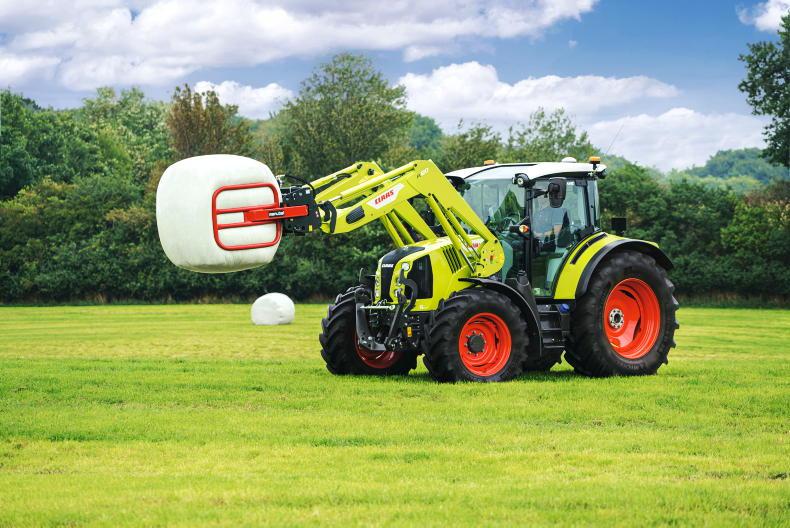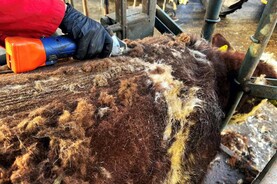Grass quality: Grass growth is very high at present. The downside of this is poor quality.
Grass quality is poor on most farms – even in Moorepark this week quality was sub-optimal. Pre-grazing yields should not exceed 1,500kg/ha, even if this means going back into paddocks at 14 to 16 day intervals.
Skip over high covers and cut them out for bales or long-term silage. Most farmers will aim to have two good-quality round bales of silage per milking cow for feeding at the shoulders of the year or during adverse weather.
Silage from surplus paddocks is high-quality, but it isn’t cheap to make and is also time consuming to make and stack. It’s looking like grass growth rates will be good for the next few weeks. Setting demand at 70kg/day by taking out area for long-term silage is probably good practice on most farms. This is a stocking rate of 4.1 cows/ha when 1kg of meal is being fed. Farms stocked less than this will end up grazing higher covers more often or having to take out a lot more paddocks as bales. Do what suits you and the farm.
Pre-mowing is not the answer to a grass quality problem, because it effects milk quality and milk yield. If grass quality is poor, the best option is to cut it for silage and the next best option is to top after grazing. Remember, topping, pre-mowing or cutting for silage will reduce grass growth rates because recovery takes longer. Really high growth rates of 100kg/day could last for two or three weeks.
Clover: Conditions are reasonably good for over-sowing clover. Over-sowing is a bit hit and miss, but best success is achieved when the area being done is small and managed carefully post sowing. The seeds can be broadcast or sown with a seeder at a rate of 2kg/ac after grazing or cutting for silage. Spreading watery slurry after sowing will help to push the clover seeds into the soil. Avoid spreading nitrogen for a few months after sowing, but some phosphorus and potash will be important for the clover seedling. Not spreading nitrogen will reduce grass growth and allow clover to get established.
Tight grazing at low covers will help to prevent the clover from being shaded out. Some clover seedling death will occur at grazing. Fields that have been over sown with clover will need to be managed carefully for the next six to 12 months. For that reason, only doing small amounts at a time will be best. Only use clover safe sprays when spraying weeds in new reseeds. DB Plus and Clovermax are the only two sprays approved for use in Ireland.
Mastitis: Many farmers are reporting higher than normal incidences of clinical mastitis this year. The cold and wet May probably didn’t help. Make sure to keep good records of all clinical cases and use that information when deciding on what cows can get selective dry cow therapy at dry off. Writing cases into a notebook will keep them all in one place, which can be occasionally uploaded to the ICBF database. It’s good policy to take a sample of milk from infected quarters before treatment, keep the samples in the freezer and then send them away for culture and sensitivity tests.
Grass quality: Grass growth is very high at present. The downside of this is poor quality.
Grass quality is poor on most farms – even in Moorepark this week quality was sub-optimal. Pre-grazing yields should not exceed 1,500kg/ha, even if this means going back into paddocks at 14 to 16 day intervals.
Skip over high covers and cut them out for bales or long-term silage. Most farmers will aim to have two good-quality round bales of silage per milking cow for feeding at the shoulders of the year or during adverse weather.
Silage from surplus paddocks is high-quality, but it isn’t cheap to make and is also time consuming to make and stack. It’s looking like grass growth rates will be good for the next few weeks. Setting demand at 70kg/day by taking out area for long-term silage is probably good practice on most farms. This is a stocking rate of 4.1 cows/ha when 1kg of meal is being fed. Farms stocked less than this will end up grazing higher covers more often or having to take out a lot more paddocks as bales. Do what suits you and the farm.
Pre-mowing is not the answer to a grass quality problem, because it effects milk quality and milk yield. If grass quality is poor, the best option is to cut it for silage and the next best option is to top after grazing. Remember, topping, pre-mowing or cutting for silage will reduce grass growth rates because recovery takes longer. Really high growth rates of 100kg/day could last for two or three weeks.
Clover: Conditions are reasonably good for over-sowing clover. Over-sowing is a bit hit and miss, but best success is achieved when the area being done is small and managed carefully post sowing. The seeds can be broadcast or sown with a seeder at a rate of 2kg/ac after grazing or cutting for silage. Spreading watery slurry after sowing will help to push the clover seeds into the soil. Avoid spreading nitrogen for a few months after sowing, but some phosphorus and potash will be important for the clover seedling. Not spreading nitrogen will reduce grass growth and allow clover to get established.
Tight grazing at low covers will help to prevent the clover from being shaded out. Some clover seedling death will occur at grazing. Fields that have been over sown with clover will need to be managed carefully for the next six to 12 months. For that reason, only doing small amounts at a time will be best. Only use clover safe sprays when spraying weeds in new reseeds. DB Plus and Clovermax are the only two sprays approved for use in Ireland.
Mastitis: Many farmers are reporting higher than normal incidences of clinical mastitis this year. The cold and wet May probably didn’t help. Make sure to keep good records of all clinical cases and use that information when deciding on what cows can get selective dry cow therapy at dry off. Writing cases into a notebook will keep them all in one place, which can be occasionally uploaded to the ICBF database. It’s good policy to take a sample of milk from infected quarters before treatment, keep the samples in the freezer and then send them away for culture and sensitivity tests.






 This is a subscriber-only article
This is a subscriber-only article










SHARING OPTIONS: